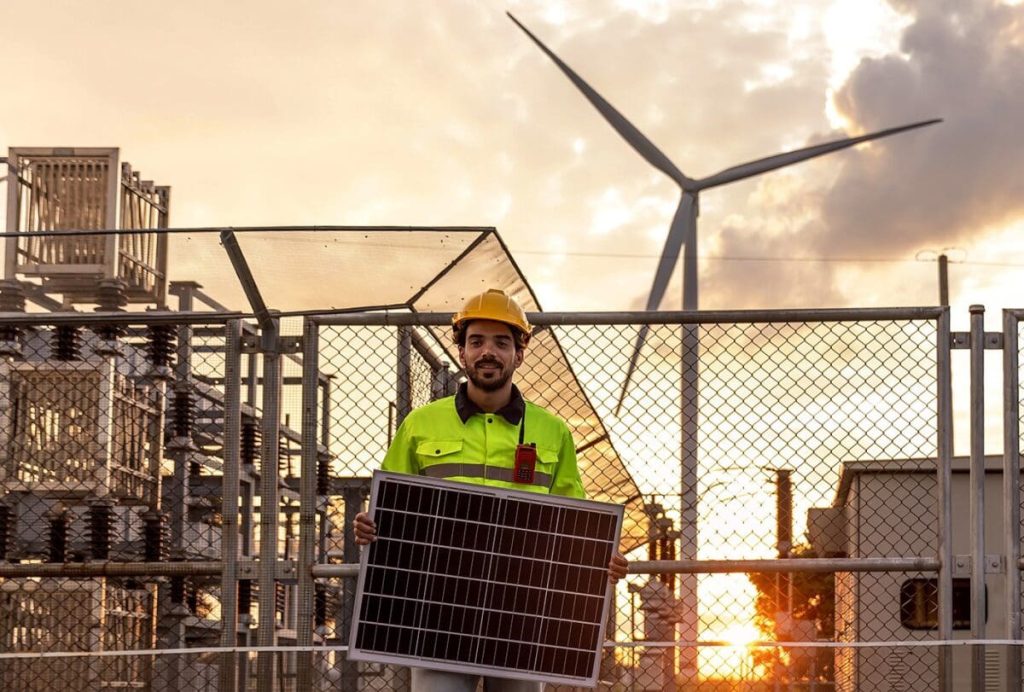
As of the beginning of 2023, there were approximately 692 microgrids within the United States. As the country (and much of the world) strives to reduce its dependence on fossil fuels and other non-renewable energy sources while improving resilience in extreme weather conditions, the use of microgrids will likely expand worldwide.
If you’re interested in sustainability and renewable energy, microgrids should be on your radar. With a better understanding of what microgrids are, how they work, and the many benefits they have to offer, you could use this knowledge to make a difference in your future career.
What Is a Microgrid?
What are microgrids, anyway? According to the National Renewable Energy Laboratory, “A microgrid is a group of interconnected loads and distributed energy resources that acts as a single controllable entity with respect to the grid.”
These independent energy systems have clearly defined electrical boundaries and can connect to a main power grid or operate completely independently of larger energy systems (macrogrids).
Typically, microgrids are composed of several different types of energy resources, which may include:
- Solar panels
- Fuel cells
- Energy storage systems
- Wind turbines
In some cases, power for a microgrid may also be derived from more traditional sources, including natural gas, combined heat and power plants, and diesel generators — although the most sustainable microgrids rely solely on renewable energy sources.
How Do Microgrids Work?
Now that we’ve outlined what a microgrid is, you may be wondering how these solutions work to provide community energy.
Microgrids can vary in their operation based on how they are configured and the specific energy sources they use. However, most microgrids will consist of some combination of the following:
- Power sources – These are the resources that produce energy for the microgrid itself. These can be renewable resources (such as wind turbines and solar panels) but may also consist of some non-renewable options — all depending on the configuration.
- Energy storage systems – As the phrase implies, an energy storage system is a device (such as a battery) where energy created can be effectively stored until demand arises. Energy storage systems can also be useful for storing power for use when there is a pause in energy generation (as may be the case at night with solar power resources).
- Control system – Microgrids also have control systems, which may consist of load management tools, metering devices, and other tools that help the microgrid operate efficiently. Additionally, a control system may handle tasks like connecting and disconnecting the microgrid to a local macrogrid as well as providing data on production and consumption.
- Distribution infrastructure – Every microgrid relies on a distribution infrastructure that is responsible for transferring power directly from its storage systems to local power lines and transformers so it can be used.
The Benefits of Microgrids
We’ve already addressed the questions, “What is a microgrid?” and “How do microgrids work?” Let’s now explore what advantages microgrids have to offer, both in terms of practical use and sustainability.
Configuration to Prioritize Renewable Energy Sources
First, consider that microgrids can easily be configured to prioritize renewable energy sources over non-renewable sources. This means that even if a microgrid is set up to generate power using a combination of renewable and non-renewable sources, the energy storage systems and control methods can work to utilize renewable energy first. This, in turn, can reduce the need for non-renewable energy sources while cutting down on greenhouse gas emissions and other environmental damage.
Greater Control Over Local Energy Production
Meanwhile, microgrids can provide greater control over local energy production, which can lead to a significantly improved sense of energy resilience. Because they can create and distribute their own power, microgrids are highly effective in providing power in remote areas where the macrogrid may be considered less reliable. Plus, because microgrids can operate independently or be connected to a larger power grid as needed, this can also help with issues of reliability and resiliency often seen in more remote areas.
Reduced Pressure on Primary Grids
By creating, storing, and distributing their own energy, microgrids can play a central role in reducing pressure on primary macrogrids across the country and even the globe. This may be especially true during times of crisis, such as when a severe weather event causes a major power outage or disruption within a local macrogrid.
When this happens, microgrids can be relied upon to reduce pressure on primary grids while providing a reliable supply of power for the most critical needs. This particular benefit of microgrids can be experienced anywhere but is perhaps most notable in areas that are at a higher risk of natural disasters or remote areas with limited access to energy from macrogrids.
Increased Efficiency
Finally, because they allow for better management of local energy resources, microgrids can make a considerable difference in overall efficiency by helping to balance power supply and demand. In addition, microgrids can be configured to allow adjustments to energy usage based on specific price signals, which could lower energy costs in some areas.
All of this combined with the simple fact that microgrids are the more sustainable energy option, and it’s evident why more of these solutions continue to be installed across the country.
The Future of Microgrids
Though microgrids offer numerous potential benefits, it is important to note that any new technology will face challenges when being set up and implemented across a large scale.
One of the biggest obstacles in the integration of microgrids into our existing energy system, for example, is the fact that they are highly customized systems with very specific variables for each project. With so many different considerations to keep in mind (including various energy sources, site locations, and other needs), the process of designing and constructing a microgrid can be a large undertaking with no shortage of red tape along the way.
Meanwhile, costs associated with the design and installation of a microgrid can be lofty — which can make getting approval for these projects challenging in various areas. The good news, however, is that costs should decrease over time as technology improves and microgrid integration becomes more widespread.
Emerging Trends in Technology
Despite some roadblocks to widespread microgrid reliance, there have been some exciting trends and advancements in this area of sustainability.
Consider, for instance, the recent integration of artificial intelligence (AI) systems into new and existing microgrid configurations. Using AI and machine learning, it is possible to automate some tasks related to power generation and distribution with a focus on efficiency and cost savings. This, in turn, can make microgrids more cost-effective and reliable.
Recent years have also shown compelling advancements in microgrid control systems. For example, one article in Energy Strategy Reviews looks at the emergence of intelligent energy management systems (EMS) and advanced energy storage systems (ESS) to “optimize the utilization and effectiveness of ESS in microgrids” and “continuously monitor and forecast energy demand and generation […] to achieve optimal operational performance.”
Green Energy Transitions
Another key fact to consider regarding microgrids is that, in many areas throughout the country and around the world, they are making it possible to transition from non-renewable and non-sustainable energy sources to more eco-friendly and sustainable options. While it may not currently be feasible for entire countries to shift to wind power or solar power, microgrids enable smaller areas to make the transition to greener energy solutions.
This may seem like a small step, yet it is actually indicative of major progress in the move to more sustainable energy sources across the board — especially in microgrid configurations that rely solely on renewable energy options.
Microgrids and Energy Resilience
Although they may only make up a fraction of the country’s energy resources now, microgrids could have a substantial impact on sustainability and renewable energy sources if their potential can be achieved. From the ability to reduce reliance on non-renewable energy sources and cut down on pressure from primary power grids to greater control over local energy production and better efficiency overall, the future of microgrids is promising.
Interested in being a part of the global energy revolution? Unity Environmental University has a program for you. Specifically, our Bachelor of Science in Sustainable Business Management with a focus on renewable energy can be an excellent fit for those who want to do their part to preserve natural resources while applying new technologies and innovation to make a difference.
Learn more about this program or any other programs offered at Unity Environmental University by getting in touch, or begin your free online application today!



